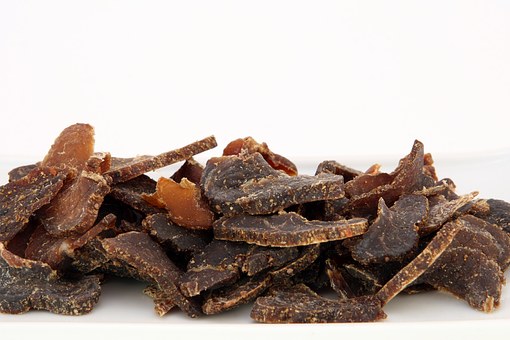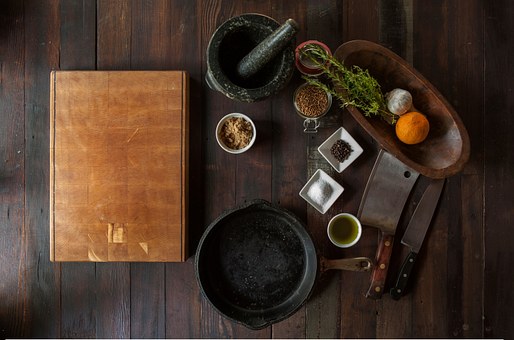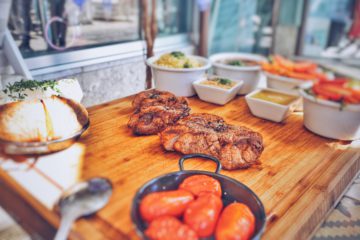If you’ve never had jerky before then “BY GOD” you don’t know what you’re missing out on!
In my opinion, jerky is by far the tastiest, most nourishing snack there is and every time I make it I can never make enough because EVERYONE I KNOW keeps coming back for more (even my Kale munchin’ vegan buds love the fruit leathers)
Now, for a long time I thought I was keeping my homemade jerky recipes “a secret” but I think it was more a case of everyone that loved my jerkys were just too damn lazy to make their own and preferred to eat my stash, which was fine but then I thought “If I’m onto something good which A LOT of people like, then why not pass these recipes on to others”
CAUTION: Your loved ones are gonna love these so either be generous and make enough for them too OR find a good hiding place to squirrel your Jerky away… Nah, just make HEAPS!
Below I’ve included 10 of my favourite homemade jerky recipes which consists of:
- Two KILLER Beef recipes
- Smokeytang Jerky
- B & C Jerky (Bourbon & Cola)
- A MOUTHWATERING pork recipe
- Pork & Apple Sauce Jerky
- A DELISH chicken recipe
- Smokey BBQ Chicken Jerky
- A SWIMINGLY DELIGHTFUL Fish recipe (That’s right folks, Fish jerky)
- Teriyaki Salmon Jerky (or you can use Trout if you choose to)
- A DROOL WORTHY Kangaroo recipe
- Red Wine Roo Jerky
- And for something different… SWEET & TASTY Fruit Leathers (Well, they’re kinda jerky…)
- 2 x ‘Lazy way’ fruit leathers (for us lazy people)
- 2 x ‘Less Lazy way’ leathers (For the less lazy ones)
What you’ll need –
- I recommend that you use a Dehydrator to make your jerky but it’s ok if you don’t have one as your oven should do the trick. NB: If using your oven, you will always need to keep the door ajar to let the hot air escape. A wooden spoon or something similar will suffice
- A medium to large mixing bowl
- Teaspoon and Table spoon
- Clear measuring jug
- Chopping board
- Sharp knife
- Medium saucepan (optional)
- large zip lock bags for marinating (optional, but if you do go the silicone ones as they’re reusable)
- Zip lock bags, containers or jars to store your Jerky
MEAT – WHAT TO USE
I have listed 5 preferences below but you are not limited to these. You can basically make jerky from any meat but the biggest thing to remember when choosing meat for making jerky is “The leaner, the better”. This is because fat won’t dehydrate and it will spoil the jerky so the less fat the meat has, the better quality jerky you’ll produce. Butchers are very knowledgeable about what cuts of meat are good for making jerky if you want to ask them but if not then here are the cuts that I prefer to use:
BEEF – Eye round and Topside (aka top round) are my go to cuts of beef as they are very lean with minimal marbling and not as expensive as other cuts but as long as the meat you choose is lean, you’ll be fine
PORK – Tenderloin and Loin roast
CHICKEN – Chicken breast
KANGAROO – I think any loin cut is good but as Roo can be hard to source, then any lean steaks you can get your hands on will do the trick
FISH – Thick, Boneless fillets of Salmon or Trout
ALWAYS SOURCE FRESH, GOOD QUALITY MEAT, POULTRY & FISH
THE METHOD – 9 Steps to JERKY HEAVEN
Follow the steps below for all the jerky recipes (except the Fruit Leathers)
I will provide the recipes and method separately with a few variations in the Chicken & Fish Jerky
NB: There is one additional step I recommend when making Jerky from poultry (i.e. Chicken and Turkey) which I will highlight in the ‘Smokey BBQ chicken’ recipe
STEP 1 – Clean your utensils, cutting board, bowls, etc thoroughly. Also, wash your hands with soap before (and even a few times during) the preparation as we want to reduce the risk of bacteria on our food
STEP 2 – For Beef, Pork, Chicken and Kangaroo Jerky, make sure you trim all excess fat from your beef (your friendly butcher might even do this for you if you ask nicely), then place your meat in the freezer for one to two hours (depending on the thickness) until it is firm to touch
STEP 3 – Take your meat out of the freezer and slice 5-6mm (approx.1/4″) strips (same with fish). Try to make the pieces around the same width for uniform drying plus ease of storage. Cut with the grain if you like your jerky chewy or across the grain if you want to give your jaw less of a workout
STEP 4 – Marinate your Jerky (see individual marinade recipes below). This is done by combining your morsels of meat (or fish) and the marinade in a large zip lock bag or bowl if you wish, making sure to give them a good mix together to get all the pieces coated and then seal and put in the fridge for between 5 and 24 hours. I tend to leave mine in for the whole 24 so the meat gets a good soaking (if I’m impatient then I’ll do 12 hrs)
STEP 5 – Remove your meat from the fridge and drain the marinade. This is done simply by tipping the meat into a colander over the sink. Place the strips of meat on some paper towel and place some paper towel on the top and pat it down to remove excess marinade (don’t worry about losing flavour as your meat would have absorbed heaps of that tasty marinade)
STEP 6 – Place your pieces onto your dehydrator tray or your (clean and lightly greased) oven or baking racks if you are using the oven method. Spread them out to ensure they are not overlapping and they get good air flow around them
STEP 7 – FIRE IT UP! Turn on your Dehydrator or oven and let’s get this show on the road! – See the temperatures for each meat in the recipes
NB: Some oven temperature don’t go as low as some of the recipes suggest so just put your oven on the lowest temperature setting and minimize the time accordingly but keep a good eye on how things are progressing. Remember to always keep the door ajar to let the hot air escape
STEP 8 – YOU HAVE DONE IT! You’ll know when your Jerky is finished when you bend it and it cracks a bit but doesn’t break. With Beef, pork and Roo Jerky, you’ll see dry, white fibres inside when you tear it (another indication that your Jerky is thoroughly dehydrated and your creation is a success). Before storing it, leave it out for bit until it gets to room temp. (but not too long)
STEP 9 – STORAGE. This is never an issue with me as my Jerky is lucky to last a week in my house so I simply throw it some zip lock bags and put it in the pantry (probably why it goes so quick… Everyone knows where I keep it) but I wouldn’t keep Homemade Jerky longer than 1-2 weeks unrefrigerated. Make sure it’s in a cool dark place
If you want to keep it for longer then I would suggest that you either put it in air tight jars or zip lock bags with a food grade desiccant bags (aka silica gel packets) thrown in to absorb any residual moisture and put in the fridge (hidden at the back from your ‘Peeps’ if you want it to last longer) that should keep up to 3 weeks
Now, for all the ‘Die hards’ who want hold onto their haul for an extended period (God know’s why), you could get yourself a vacuum sealer and seal your Jerky up (again with a desiccant bag thrown in), throw it in the freezer and that should ‘keep’ for up to a year (you will however lose a bit of flavour)
…NOTHING TO DO NOW BUT KICK BACK WITH A NICE “COLD ONE” AND ENJOY!
RECIPES
Smokeytang Jerky
INGREDIENTS
1kg (2.2 lbs) Topside Beef(prepared as in STEPS 2 & 3)
100ml (approx. half a cup) Worcestershire sauce
100ml Soy sauce (low sodium)
100ml Balsamic vinegar
3 tbsp Brown sugar
1 tbsp minced garlic
1.5 tbsp mesquite liquid smoke (or whatever liquid smoke you can get your hands on)
1 tsp ground sea salt
1 tsp ground peppercorns
1 tsp onion powder
1 tsp crushed dried chilli (more if you like it hotter)
MIX INGREDIENTS (EXCLUDING THE BEEF) IN A BOWL AND STIR WELL. ALTERNATIVELY MIX IN A SAUCEPAN OVER A LOW HEAT AND STIR UNTIL DISSOLVED. If heating, then let cool before adding beef
FOLLOW ON FROM STEP 4
SET YOUR DEHYDRATOR OR OVEN TEMPERATURE TO 71°C (160°F)
CHECK YOUR MEAT AFTER 8 HOURS. Rotate trays and/or turn meat over (remember, clean hands) if required at this stage
PERIODICALLY CHECK YOUR MEAT. Depending on the thickness and moisture content of your meat, Quantity, Quality of dehydrator, Humidity, etc. it is not uncommon for the dehydration process to take up to 24hrs. You will become more accustomed to dehydrating times with more experience
B & C Jerky (Bourbon & Cola)
INGREDIENTS
1kg (2.2 lbs) Topside Beef (prepared as in STEPS 2 & 3)
240ml (approx. 1 cup) Bourbon of your choice (JD for me!)
480ml (approx. 2 cups) Cola (I ain’t gonna comment here Pepsi lovers)
60ml (approx. quarter cup) Soy sauce (low sodium)
1.5 tbsp mesquite liquid smoke
1 tbsp onion powder
3 tbsp Honey
3 tbsp Brown sugar
1 tsp crushed dried chilli (more if you like it hotter)
MIX INGREDIENTS (EXCLUDING THE BEEF) IN A BOWL AND STIR WELL. ALTERNATIVELY MIX IN A SAUCEPAN OVER A LOW HEAT AND STIR UNTIL DISSOLVED. If heating, then let cool before adding beef
FOLLOW ON FROM STEP 4
SET YOUR DEHYDRATOR OR OVEN TEMPERATURE TO 71°C (160°F)
CHECK YOUR MEAT AFTER 8 HOURS. Rotate trays and/or turn meat over (remember, clean hands) if required at this stage
PERIODICALLY CHECK YOUR MEAT. Depending on the thickness and moisture content of your meat, Quantity, Quality of dehydrator, Humidity, etc. it is not uncommon for the dehydration process to take up to 24hrs. You will become more accustomed to dehydrating times with more experience
Pork & Apple Sauce Jerky
INGREDIENTS
1kg (approx. 2.2 lbs) Pork tenderloin (prepared as in STEPS 2 & 3)
370ml Apple sauce
250ml 100% Apple juice
1 tsp cinnamon
1 tsp ground sea salt
1 tsp ground peppercorns
3 tbsp Brown sugar
1.5 tbsp mesquite liquid smoke
1 tbsp minced garlic
MIX INGREDIENTS (EXCLUDING THE PORK) IN A BOWL AND STIR WELL. ALTERNATIVELY MIX IN A SAUCEPAN OVER A LOW HEAT AND STIR UNTIL DISSOLVED. If heating, then let cool before adding Pork
FOLLOW ON FROM STEP 4
SET YOUR DEHYDRATOR OR OVEN TEMPERATURE TO 71°C (160°F)
CHECK YOUR MEAT AFTER 8 HOURS. Rotate trays and/or turn Pork over (remember, clean hands) if required at this stage
PERIODICALLY CHECK YOUR MEAT. Depending on the thickness and moisture content of your Pork, Quantity, Quality of dehydrator, Humidity, etc. it is not uncommon for the dehydration process to take up to 24hrs. You will become more accustomed to dehydrating times with more experience
Smokey BBQ Chicken Jerky
NB: It is recommended when dehydrating poultry that it is first brought to an internal temperature of 74°C (165°F) to ensure any harmful bacteria is killed. This can be done by laying the poultry strips onto greased baking racks and putting into a preheated oven at 150°C (a little over 300°F) for around 5 minutes prior to dehydrating. The dehydrating time will decrease because of this. See ‘Check your Chicken…’ below
All ovens are different so you may want to consider buying an oven/meat thermometer for more accuracy in checking the temperature of your food. They’re a cheap, handy little gadget to have
INGREDIENTS
1kg (approx. 2.2 lbs) Chicken Breast (prepared as in STEPS 2 & 3)
100ml (approx. half a cup) Worcestershire sauce
100ml Maple Syrup
100ml Soy sauce (low sodium)
1 tbsp minced garlic
1.5 tbsp Hickory liquid smoke
1 tsp ground sea salt
1 tsp ground peppercorns
1 tsp onion powder
MIX INGREDIENTS (EXCLUDING THE CHICKEN) IN A BOWL AND STIR WELL. ALTERNATIVELY MIX IN A SAUCEPAN OVER A LOW HEAT AND STIR UNTIL DISSOLVED. If heating, then let cool before adding Chicken
FOLLOW ON FROM STEP 4. Not forgetting the note above. Do this in between stages 5 & 6
SET YOUR DEHYDRATOR OR OVEN TEMPERATURE TO 71°C (160°F)
CHECK YOUR CHICKEN AFTER 5 HOURS. Rotate trays and/or turn Chicken over (remember, clean hands) if required at this stage
PERIODICALLY CHECK YOUR CHICKEN. Depending on the thickness and moisture content of your Chicken, Quantity, Quality of dehydrator, Humidity, etc. it is not uncommon for the dehydration process to take up to 18hrs. You will become more accustomed to dehydrating times with more experience
Red Wine Roo Jerky
INGREDIENTS
1kg (approx. 2.2 lbs) Kangaroo loin (prepared as in STEPS 2 & 3)
480ml (approx. 2 cups) Red Wine (the cheap stuff will do)
120ml Balsamic vinegar
2 tbsp minced garlic
1 tsp crushed dried chilli (more if you like it hotter)
1 tsp onion powder
1 tsp ground sea salt
1 tsp ground peppercorns
1 tbsp chopped Rosemary leaves
MIX INGREDIENTS (EXCLUDING THE MEAT) IN A BOWL AND STIR WELL. ALTERNATIVELY MIX IN A SAUCEPAN OVER A LOW HEAT AND STIR UNTIL DISSOLVED. If heating, then let cool before adding meat
FOLLOW ON FROM STEP 4
SET YOUR DEHYDRATOR OR OVEN TEMPERATURE TO 71°C (160°F)
CHECK YOUR MEAT AFTER 8 HOURS. Rotate trays and/or turn meat over (remember, clean hands) if required at this stage
PERIODICALLY CHECK YOUR MEAT. Depending on the thickness and moisture content of your meat, Quantity, Quality of dehydrator, Humidity, etc. it is not uncommon for the dehydration process to take up to 24hrs. You will become more accustomed to dehydrating times with more experience
Teriyaki Salmon Jerky
NB: Some steps vary a bit in this recipe from the ones above but we’ll have a look at this after the ingredients…
INGREDIENTS
Approx.1kg (approx. 2.2 lbs) raw Salmon – My Tip: Wild caught is better than farmed
250ml (a bit over a cup) Soy sauce (low sodium)
4 tbsp Brown sugar
2 tbsp Lemon juice
1 tbsp minced garlic
1 tbsp ground ginger
3 tbsp Honey
1.5 tbsp Hickory liquid smoke
1 tsp ground peppercorns
Firstly, with a very sharp knife, cut your fish length ways into 5-6mm (approx.1/4″) strips and then cut each strip into approx. 10cm (4 inch) lengths, LEAVING THE SKIN ON. This will hold the fish together during the marinating and drying process. It is easily removed before eating
MIX INGREDIENTS (EXCLUDING THE FISH) IN A BOWL AND STIR WELL. ALTERNATIVELY MIX IN A SAUCEPAN OVER A LOW HEAT AND STIR UNTIL DISSOLVED. If heating, then let cool before adding Fish
FOLLOW ON FROM STEP 4
SET YOUR DEHYDRATOR OR OVEN TEMPERATURE TO 66°C (150°F)
CHECK YOUR FISH AFTER 4 HOURS. Rotate trays and/or turn Fish over (remember, clean hands) if required at this stage
PERIODICALLY CHECK YOUR FISH. Depending on the thickness and oil & moisture content of your Fish, Quantity, Quality of dehydrator, Humidity, etc. it is not uncommon for the dehydration process to take up to 18hrs. You will become more accustomed to dehydrating times with more experience
As the Fish will be oilier than meat and poultry, it’s a good idea to ‘pat down’ the finished product with paper towel to removed excess fish oils… Don’t worry, you won’t lose any taste
SWEET & TASTY FRUIT LEATHERS
There are two ways you can do Fruit Leathers (aka fruit roll ups), and that is the ‘LAZY WAY’ (using prepackaged foods) or the ‘LESS LAZY WAY’ (using fresh produce)
and me being “me”, I choose to do this the Lazy way but I will give you some tips on doing it both ways as after all, the Less lazy way is probably the best way as you can source your own fresh fruit and know exactly what you’re getting
Directions for all the recipes at the bottom
THE ‘LAZY WAY’ RECIPES
APPLESAUCE & MANGO LEATHERS
INGREDIENTS
2 cups of (store bought) frozen mango chunks
2 cups Applesauce
2 tbsp Honey
1 tbsp Lemon Juice
PINEAPPLE & BERRY CHEWIES
INGREDIENTS
2 cups (store bought) frozen mixed Berries
1 cup (store bought) frozen Pineapple chunks
1 cups Applesauce
2 tbsp Honey
1 tbsp Lemon Juice
THE ‘LESS LAZY WAY’ RECIPES
BANANACINABERRY STRIPS (Banana, cinnamon and Strawberry)
INGREDIENTS
2 cups VERY ripe Banana, chopped (1-2 inch pieces)
2 cups chopped Strawberries
1 tsp Cinnamon
2 tbsp Honey
1 tbsp Lemon juice
APPLE & SWEET TATER STRAPS
INGREDIENTS
2 cups Applesauce
2 cups cooked and diced Sweet potatoes
1 tspn Cinnamon
4 tbsp Honey
1 tbsp Lemon Juice
DIRECTIONS FOR ALL RECIPES
Put all ingredients of the recipe into a blender or food processor and blend until you get a smooth, thick puree
If you are using a Dehydrator, you’ll need to use your “Roll up” trays for this but if you are using an oven you can either lay some parchment paper (aka baking paper) or a Silicon mat on a baking tray
Pour the puree onto the tray/s starting from the centre and slowly “swirl around” keeping an even consistency until you have reached the outer edges. Using a Spatula, spread out the mixture keeping an even thickness of around 5mm. Try not to let the outer edges get too thin as they tend to get “crispy” but don’t worry if they are as you can just trim them at the end of the process
Put your tray/s into your dehydrator and set at 65°C (149°F). If using your oven then set to the lowest temperature and keep the door ajar
Check your leathers after 3 hrs and then continually check until done
PERIODICALLY CHECK YOUR LEATHERS. Depending on the thickness & moisture content of your Fruit Leathers, Quantity, Quality of dehydrator, Humidity, etc. It is not uncommon for the dehydration process to take up to 10hrs. They will be ready when they are not sticky to touch and not “squishy” when you press down with your finger. You will become more accustomed to dehydrating times with more experience
Once your Fruit leathers are done, you can leave them on the parchment paper and cut into 2 inch wide strips using clean scissors or kitchen shears and roll them up and store in an airtight jar. If done on Silicon mats or dehydrator trays then you can simply remove and cut into strips. Think ‘Pizza cutter’ for this (way better than a knife)
Try making these yourselves at home. You won’t regret it…or maybe you will when your friends keep hitting you up to make more 🙂
HAPPY ADVENTURES!



0 Comments